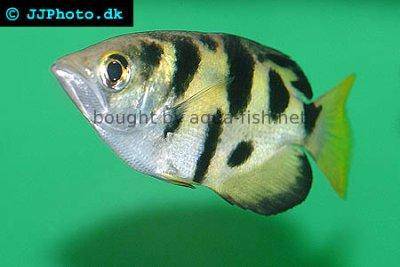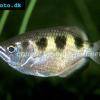Smallscale archerfish - Toxotes microlepis
Scientific name: Toxotes microlepis
Common name: Smallscale archerfish
Family: Toxotidae
Usual size in fish tanks: 14 - 18 cm (5.51 - 7.09 inch)
014
Recommended pH range: 6.5 - 8
Recommended water hardness: 6 - 21°N (107.14 - 375ppm)
0°C 32°F30°C 86°F
Recommended temperature range: 24 - 28 °C (75.2 - 82.4°F)
The way how these fish reproduce: Spawning
Where the species comes from: Southeast Asia
Temperament to its own species: peaceful
Temperament toward other fish species: peaceful
Usual place in the tank: Middle levels
Overview
Toxotes microlepis (Smallscale Archerfish) is a surface-oriented predator famed for shooting jets of water to knock insects from overhanging vegetation. Unlike some congeners, this species is primarily freshwater, inhabiting large lowland rivers and floodplains in mainland Southeast Asia and parts of Sundaland.
Care & Tank Setup
- Group: Keep in small groups of 5–8 to reduce skittishness; expect a loose hierarchy.
- Tank: Long tank with generous surface area; 120 cm / 250 l (65 gal) minimum for a group. Tight-fitting lid—excellent jumpers.
- Water: pH 6.5–8.0, hardness 6–21 °dGH, temperature 24–28 °C (75–82 °F). Clean, well-oxygenated water and steady parameters are crucial.
- Salinity: Freshwater by default; optional very light brackish (SG ≤ 1.005) is tolerated but not required long-term.
- Aquascape: Open surface for feeding shots, with driftwood/branches or emergent plants to simulate overhangs. Gentle flow; strong filtration.
Diet & Feeding
Obligate carnivore focused on insects and small aquatic prey.
- Staples: Quality floating carnivore pellets/sticks (to encourage surface feeding).
- Frozen/live: Crickets, houseflies, mealworm/pupae pieces, mosquito larvae, Daphnia, brine shrimp, chopped prawn.
- Training: Present food slightly above the waterline to encourage the iconic spitting behavior (protect lights/lids!).
- Avoid: “Vegetable matter/seaweed” – not required; this species is not herbivorous. Do not use very small tankmates as “food.”
Behavior & Compatibility
- Conspecifics: Semi-gregarious; minor skirmishes are common, but larger spaces reduce stress.
- Other fish: Best with robust, similarly sized mid- or bottom-dwelling species (e.g., larger rainbowfish, gobies, catfish). Small surface-dwellers will be preyed upon.
Sexing
No reliable external differences are known; males may show subtle proportional variations, but sexing remains uncertain.
Breeding
Home breeding is extremely rare; commercial operations use large facilities and often hormonal induction. Believed to be a substrate spawner with small adhesive eggs and no parental care.
Lifespan
Typically 8–12 years, occasionally longer with excellent care.
Origin
Mainland Southeast Asia (Mekong, Chao Phraya and adjacent river systems), Malay Peninsula, Sumatra, and Borneo. Most often found in freshwater rivers, flooded forests, and slow-flowing side channels.
Short description
Best kept in spacious, well-covered aquaria with open surface areas and overhanging structures. Group housing, surface feeding, and excellent filtration are the keys to long-term success.
At-a-Glance (Care Box)
- Size (captive): 14–18 cm TL (up to ~20 cm)
- Temperament: Semi-gregarious; predator of small surface fish
- pH: 6.5–8.0 | GH: 6–21 °dGH
- Temp: 24–28 °C (75–82 °F)
- Salinity: Freshwater (light brackish tolerated, not required)
- Tank: Group in ≥ 250 l / 65 gal; long tank, secure lid
- Diet: Insects and small prey; floating pellets, insects, larvae
- Breeding: Rare in home aquaria; likely substrate spawner
- Lifespan: 8–12 years
Pictures
Bought by aqua-fish.net from jjphoto.dk.


 Archer
Archer